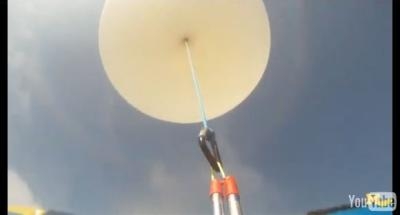'For A Couple Of Hundred Dollars, You Can Reach The Fringe Of Space'
More than 60 teams from around the world will launch high-altitude balloons into the upper atmosphere April 18-21. The Global Space Balloon Challenge, organized by graduate students at the University of Michigan, Stanford University and MIT, has attracted crews from 20 countries so far.

They include enthusiasts in Sydney, Australia, who call themselves the "Brolooners," an eighth-grade class in rural New Hampshire, and advanced teams from the organizing universities. While judges will award prizes in several categories, the contest's mission is to get young people involved in hands-on science, technology, engineering and math projects.
"Put anything in the air and kids are with you," said Steven Roberts, an eighth grade science teacher in Meredith, N.H., whose class will launch its own balloon. "They'll stay after school. They'll build. It gives them enthusiasm to learn. When you just have a straight curriculum without imagination it's dry and they want to get out, and I don't blame them. We're a little rural school. If we don't open their eyes to what's out there, they get lost."
High-altitude balloons provide low-cost, low-risk opportunities to test and develop the next generation of space exploration technology, organizers say. It's much easier to test and retrieve equipment in a near-space environment using balloons than by launching expensive rockets.
"Everything that you do in high-altitude flying is analogous to the building blocks of a satellite mission," said Nathan Hamet, U-M graduate student in atmospheric, oceanic and space sciences and project leader of the Michigan Balloon Recovery and Satellite Testbed student organization.
The balloon that Michigan's team plans to launch will include new technology that Hamet says will push the boundaries of what high-altitude balloon experimentation can accomplish. Typically, the gasses in the balloon will continue to expand as the pressure decreases with altitude, ultimately causing it to burst, which limits the amount of time in which data can be collected in a near-space environment.
U-M is developing a regulator on the flight vessel that will control the amount of gas in the balloon. If successful, it will allow the balloon to hang at a specific altitude for much longer periods of time, allowing them to perform longer experiments and collect more data.
The eighth grade team won't be pushing the boundaries of balloon technology, but they're accomplishing something else important, Roberts says. They're getting excited about science, technology, engineering and math education (STEM).
Roberts hopes the experience will open the doors for ongoing science projects that the class can pursue. For example, one student suggested that in the future they might send seeds up with their balloon, and then plant them afterwards. The class could compare growth rates with other seeds that weren't launched to determine if increased exposure to the sun's radiation had any effect. Another ambition is to get the local community involved. One of his ideas is to work with local amateur radio operators to help the class track their balloon. Another idea is to help monitor local lake-ice melt rates.
"The other cool thing is being able to talk to universities, because I have a lot of kids that think they can't do it," he said. "Having that connection with the different schools shows them that other young people are doing this, and what is possible."
The feeling is mutual for the event organizers. "Even if it changes the lives of just a couple kids and gets them into the STEM field, that makes it worth it for me at least," said Duncan Miller, a graduate student at MIT studying aeronautics and astronautics with a bachelor's degree from U-M in aerospace engineering.
"The chase is definitely exciting. You don't really know where your balloon is going to land. Are you going to get it back? Is the payload working? When you find it 50 miles or so away and you get some good science back, it's really rewarding."
David Gerson, a Stanford graduate student studying aeronautics and astronautics, says it's a fun way to show people that they can get involved in space science.
"For a couple hundred dollars, you can get to the edge of space," he said.
(Image from UM YouTube video)
 ANN's Daily Aero-Term (04.26.24): DETRESFA (Distress Phrase)
ANN's Daily Aero-Term (04.26.24): DETRESFA (Distress Phrase) ANN's Daily Aero-Linx (04.26.24)
ANN's Daily Aero-Linx (04.26.24) Airborne 04.22.24: Rotor X Worsens, Airport Fees 4 FNB?, USMC Drone Pilot
Airborne 04.22.24: Rotor X Worsens, Airport Fees 4 FNB?, USMC Drone Pilot Airborne 04.24.24: INTEGRAL E, Elixir USA, M700 RVSM
Airborne 04.24.24: INTEGRAL E, Elixir USA, M700 RVSM Airborne-NextGen 04.23.24: UAVOS UVH 170, magni650 Engine, World eVTOL Directory
Airborne-NextGen 04.23.24: UAVOS UVH 170, magni650 Engine, World eVTOL Directory



